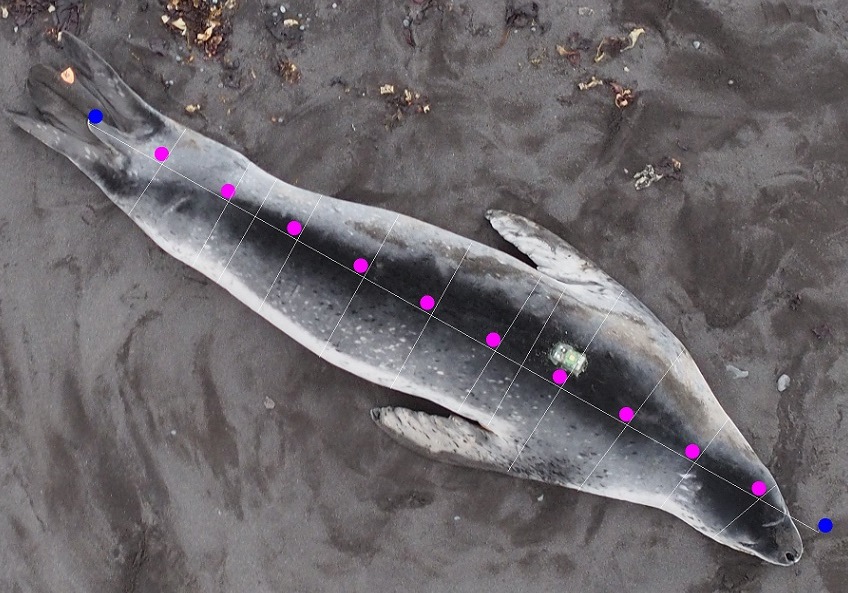- Scientists tested the accuracy of determining marine mammal size by analyzing aerial photography taken from a small drone as a less costly, less stressful alternative to manual capture and measurement.
- To be precise in their measurements of leopard seals, the researchers took overhead photographs at three different altitudes, and three scientists measured the photographs of each seal independently.
- They found that the new aerial photography method produces results comparable to standard manual methods.
Scientists in Antarctica recently tested a novel technique to measure the body size and mass of wildlife — aerial photography.
The method, used on leopard seals (Hydrurga leptonyx), allows scientists to take necessary measurements of individual animals from aerial photos without spending the substantial time, labor and resources needed to physically capture them. It also avoids the stress that capture could cause the animals.

The study, “An accurate and adaptable photogrammetric approach for estimating the mass and body condition of pinnipeds using an unmanned aerial system,” took place in Cape Shirref, Livingstone Island, Antarctica. Leopard seals are seasonally resident and already marked in this area.
Historically, scientists have measured seals by darting the animal with a sedative, and maintaining sedation intravenously, Krause said. Once scientists sedated the animal, they would sample it, take all necessary measurements, reverse the sedative and release it, and then monitor it to ensure it recovered fully.
The team tested the feasibility of aerial photography analysis to replace manual techniques. They went through several steps to ensure the best results, including taking photos of each animal immediately after capture from an unmanned aerial system (UAS), from four different altitudes for comparison. The UAS included a camera mounted on a small drone. Identifying information was removed from the test photos to avoid bias. Three independent observers also measured the animal’s length and width at standard locations in each photo.
Using aerial photography, the researchers could measure body size, or straight-line distance from the snout to the tip of the tail, within about 2 percent and mass within about 4 percent of manual measurements.

“We’re talking about being within 40 or 50 pounds on a 1100-pound animal,” said lead author Douglas J. Krause of the NOAA Southwest Fisheries Science Center. “Our confidence and our ability to take those measurements is just as good as if we had that seal sedated on the ground, right next to us.”
According to the study, measuring body size and mass can provide information about the age, physiology, foraging ecology, life history and evolution of marine animals. Krause said that taking these measurements on leopard seals specifically is especially important because they can indicate the health of the entire ecosystem and how it may be impacted by climate change.
Leopard seals are one of Antarctica’s top predators and, like many other marine predator species, a major consumer of krill. Tracking the health of leopard seals leads to a better understanding of the health of krill populations and, in turn, the health of many other Antarctic species.

Krause said their major limitation in comparing ground and photographic measurements was the time and effort they put into manually capturing and measuring an adequate-size sample of leopard seals for initial testing. After measuring the seals on the ground, they were able to compare the results from the UAS.
“Because we took the time to develop this technique and verify that it’s doing what we think it’s doing, we can feel confident about gathering monitoring information in the future that will both help us understand ecosystem function and also give us better data to support conservation efforts,” Krause said.
Krause and his colleagues have worked with leopard seals in the Antarctic for many years, which allowed them to avoid many potential complications such as unfamiliarity with the terrain or species. Additionally, Krause said, they chose a robust UAS model that was able to fly in snow, rain and winds up to 22 knots.
The UAS, made by Aerial Imaging Solutions, is currently used across NOAA Fisheries systems. With the drone system, Krause said, they can now measure an adult female leopard seal—which could weigh over 500 kg and would normally require a several-member team to safely capture—in just a few minutes. Additionally, they can measure more seals over a broader range than was possible with ground captures.

“While we could capture 17 individual leopard seals over two years manually,” Krause said, “we can now easily survey dozens of animals over a much broader area.”
The vertical take-off and landing (VTOL) UAS technology helped reduce error in the measurements itself. Krause said the team had to do fewer angular corrections because the quadcopter drone is self-leveling, and the photographs taken with a camera-sensor matched lens resulted in few distortions.
The battery-powered UAS is also relatively quiet to avoid disturbing wildlife in the surrounding area. In this case, the researchers did not detect any behavioral response to the UAS being flown at least 23 m (75 ft) above them.
Krause envisions this study as an important step forward in conservation and determining the health of individual species and entire ecosystems. He said one limitation other scientists experienced in using this method is confidence in the technology, which he hopes this publication will solve.
“I think we’re going to certainly see it more and more within the marine mammal community, specifically on animals like whales that you don’t even have the option to perform a manual capture. I would also not be surprised to see a similar approach to this applied more widely to terrestrial animals.”

FEEDBACK: Use this form to send a message to the editor of this post. If you want to post a public comment, you can do that at the bottom of the page.
